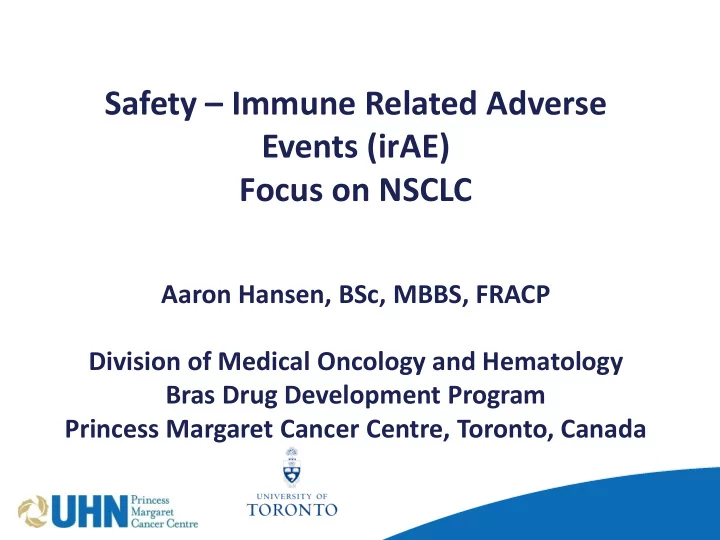

Safety – Immune Related Adverse Events (irAE) Focus on NSCLC Aaron Hansen, BSc, MBBS, FRACP Division of Medical Oncology and Hematology Bras Drug Development Program Princess Margaret Cancer Centre, Toronto, Canada
Overview • Mechanisms driving ir-AE • ir-AE reporting in clinical trials • Variations in ir-AE profile – as per treatment – as per tumor type • Impact on HRQOL
Updated Systematic Review of Single Agent ICI Trials Tumor Sites Total no. of Melanoma NSCLC RCC Other pts per agent Agents Pembrolizumab 1220 495 71 1786 (26%) Nivolumab 828 535 573 355 2291 (33%) BMS-936559 207 207 (3%) MDPL3280A 68 68 (1%) Ipilimumab 1454 61 80 1595 (23%) Tremelimumab 782 143 925 (13%) Total no. of pts per 4284 (62%) 1020 (15%) 634 (9%) 924 (13%) 6872 tumor site
NSCLC PD-1 Trials: irAE irAE Nivolumab (n=535) Pembrolizumab (n=495) ≥G3 ≥G3 All Grades All Grades Fatigue 19% <1% 19% <1% Pruritus 11% 0% 6% <1% Anorexia 11% 1% 12% <1% Rash 9% <1% 8% <1% Arthralgia 9% <1% 4% 0% Pneumonitis 4% 2% 3% 1.5%
Mechanisms Driving ir-AE Immune Checkpoints and Associations with Autoimmune Pulmonary Disease
Immune Checkpoints CTLA-4 PD-1/PD-L1 • Genome wide search identified • IHC revealed increased PD-L1 linkages between asthma and 2q33 expression in sarcoidosis granulomas 1 (region encoding CTLA-4 ) in hispanics 1 • In lupus susceptible mice, PD-L1 • SNPs in CTLA-4 gene associated expression protects against fatal pneumonitis 2 with asthma, atopy and chronic bronchitis 2,3 • T-helper cells from patients with • CTLA-4 polymorphisms are granulomatosis with polyangiitis associated with COPD in Chinese (Wegeners granulomatosis) had patients 4 higher PD-1 expression 3 • Murine models of acute lung injury have demonstrated CTLA-4 contribute to pulmonary inflammation 5 1 CSGA Nat Genet 1997, 2 Munthe-Kaas JACI 2004, 3 1 Braun Am J Respir Crit Care 2014, 2 Lucas J Immunol Zhu ERS 2009, 4 Liu Human Imm 2010, 5 Nakajima J 2008, 3 Wilde Rheumatol 2011. ERS 2009 Immunol 2010
ICI cause pulmonary ir-AE by: • Affecting tissue infiltrating lymphocytes • Changing cytokine profiles • Modulating immune checkpoints associated with pulmonary autoimmune diseases
Reporting of ir-AE in Clinical Trials Reporting has improved over time but needs to be more comprehensive
Components of the 21-point quality score and the scoring of each item T. W. Chen et al. Ann Oncol 2015
Distribution of the Quality Scores for reporting of irAE N=50 studies T. W. Chen et al. Ann Oncol 2015
ir-AE from ICI of different classes PD-1/PD-L1 inhibitors and CTLA-4 inhibitors have different toxicity profiles
PD-1/PD-L1 CTLA-4 OR (95% CI) OR (95% CI) Pneumonitis Colitis 6.42 (3.24-12.74) 8.66 (5.83-12.89) Myalgia Hypohysitis 4.99 (2.6-8.70) 6.54 (2.99-14.29) Hypothyroidism Rash 4.29 (2.92-6.31) 2.04 (1.78-2.32) Arthralgia Pruritis 3.54 (2.63-5.34) 1.82 (1.6-2.06) 14 Unpublished data Hansen et al
ir-AE as per Tumor Type ICI can have a histology-specific ir-AE profile
PD-1 Clinical Trials irAE p value Melanoma vs RCC p value Melanoma vs NSCLC OR (95% CI) OR, 95% CI Colitis 4.2, 1.3-14.0 0.01 NA (No event for RCC) Diarrhea 1.9, 1.5-2.5 1.3, 1.1-1.8 0.04 Pruritus 2.4, 1.9-3.1 1.5, 1.2-2.0 0.003 Rash 1.8, 1.4-2.3 1.6, 1.2-2.1 0.002 <0.001 Pneumonitis 0.4, 0.3-0.7 0.3, 0.2-0.6 <0.001 Unpublished data Hansen et al
Combination Regimens have higher irAE frequency
Impact of ir-AE on QOL Development and Validation of a Patient Reported Outcome tool to assess QOL from Immune Checkpoint Therapy
Quality of Life (QoL) • Impact of ICI on health related QoL is currently unknown • Evaluation of QoL will be important to determining clinical benefit • Generic tools to assess QoL are being incorporated into clinical trials of ICI e.g. EORTC QLQ-C30 • Need for a ICI specific QoL instrument 19
FAC FACT-IC ICM Developme lopment a t and V Valida dation tion of Function tional l Asses essment o of Can Cancer cer Th Ther erap apy – Immune une Checkpoin kpoint M t Modu dulators tors Prin Princess Margar garet C Can ancer C Centre Tumor I Immunotherap apy P Progr gram am Odette te C Cancer C Centr tre Sunny nybrook H Health S h Scienc nces Centre
Overall Study Design
Regulators Perspective Drug Approval • Given similar ORR with single agent ICI trials, toxicity is an important consideration • To improve survival, combination ICI regimens are being tested [irAE must be appropriately reported] • Frequency and severity of irAE is higher with combination regiments → ↓ QoL • New drug(s) approval will depend equally on survival outcomes and toxicity 22
Questions Contact: aaron.hansen@uhn.ca 416 946 4501 ext 5606
Management of ir-AEs Organ irAE Management Skin Pruritus, Rash, Vitiligo, Toxic General Guidelines: Epidermal Necrosis 1. Thorough Investigation to exclude other causes, for example: blood work, GI Diarrhea, Colitis, Abdominal hormonal panels, cultures, CT scans, Pain, Bowel Perforation bronchoscopy, colonoscopy etc ⬆ AST/ALT Liver 2. Initial symptom management: O2, oral or IV fluids, electrolyte replacement, anti- Lung Pneumonitis emetics, anti-diarrheals, anti-histamines, Endocrine Thyroid, adrenal, hormonal replacement hypothalamus abnormalities 3. For more severe toxicities consider oral Nervous Neuropathy, Guillain-Barre, or IV steroids till symptom resolution and Myasthenia Gravis then steroid taper 4. Other immunosuppressants eg infliximab Eye Uveitis 5. Surgery, ventilation, inotropes etc Kidney Nephritis Remember protocol specific management guidelines for certain ir-AEs. 24
Recommend
More recommend